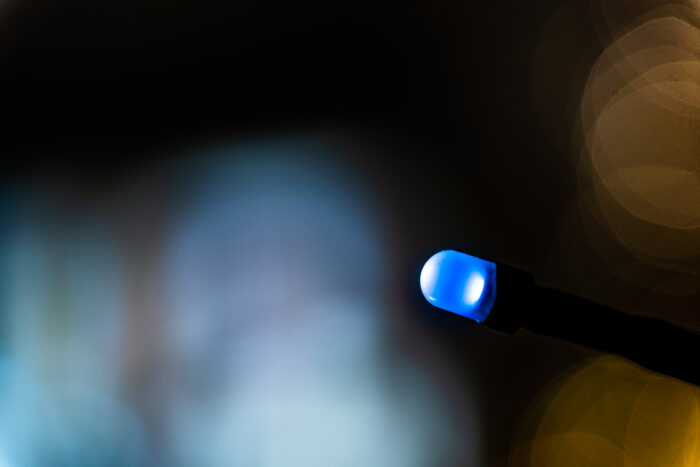Recently, my family and I went to a destination bar mitzvah about an hour and a half from L.A. All five of my kids packed up for a fun weekend, and we arrived at the hotel before Shabbat. We left the bathroom light on in the hotel room just right before Shabbat began, because we don’t turn on and off electric switches on Shabbat. But when we returned from dinner that night, everything had gone pitch black. The hotel’s timer system had shut off the lights.
We fumbled our way through the darkness and eventually went to bed. But in the middle of the night, my youngest needed the restroom. I led her there, barely able to see—but then I noticed a tiny blue light from a ceiling sensor. That tiny glow gave my eyes just enough light to help her.
I thought, “Wow! That tiny blue light really saved the night.”
The next morning, sunlight flooded the room through the curtains. Suddenly, the blue light became completely invisible. It was so dim in comparison, it was like it didn’t even exist.
That moment hit me hard.
We go through life thinking that our little blue lights—our moments of connection to the Divine, to Hashem—are enough; that they’re sustaining us. And in a way, they are. But we don’t even realize how much more light is available to us. We don’t realize what we’re missing.
Tisha B’Av, which commemorates the destruction of the Beit HaMikdash, the holy Temple in Jerusalem in 70 CE, is a day of mourning. But the truth is, we’re mourning something we can’t even fully comprehend. We’ve never experienced the light of the Beit Hamikdash while it stood.
The journey of exile has been a long and arduous one for the Jewish people. In the generations that have followed the destruction of the Beit HaMikdash, Jews have asked ourselves: How can we sustain ourselves without the Beit Hamikdash?
We think we’re doing fine with what we have, with our little flickers of spirituality. But compared to the light we could have? It’s nothing.
So what do we do? If we don’t yet have the Beit Hamikdash—if that full, Divine light hasn’t returned—how do we move forward?
We tap into our own inner light.
That light is our neshama, our soul. It’s the same light I remember feeling as a young teenager saying the Shema at night, wondering if Hashem even heard me. Even when in doubt, even when I didn’t feel connected, I wanted to be connected. That desire was the inner spark. And it never left me. It has guided me throughout my life.
That light exists in every Jew. Whether you’re 8 or 80, it’s the same soul-light inside. You carry it with you always.
Everyone experiences times of disconnection. But it doesn’t matter if a Jew has gone off the path, if they are experiencing a difficult year or week. That pintele yid, that inner point of light, will always bring you back. No matter how long or arduous the journey, that inner light will guide you home.
And we see this lesson not just in Torah, but in nature. At the bar mitzvah in Los Angeles, we heard a powerful lesson from Rabbi David Saks. He spoke about the Monarch butterfly, a creature with a short lifespan that migrates all the way from Mexico to Canada. But here’s the catch: the butterflies that start the journey die mid-way through. It takes several generations to complete the trip. So how do they know where to go?
Hashem implanted in them an inner GPS—an inner drive that keeps their journey going. If a butterfly has that, how much more so do we, Hashem’s children, have a soul that pulls us toward Him, no matter how lost we feel.
And here’s a fascinating detail about the Beit Hamikdash: the windows were built narrow on the outside and wide on the inside—the opposite of typical architecture. Most windows are built to bring in light from the outside. But the Beit Hamikdash wasn’t built to receive light. It was built to give off light. Its glow came from within, just like ours must.
Each of us is a mini Beit Hamikdash. Our bodies house our precious souls.
Now, let’s return to the blue light.
We all live with a blue light today, namely our phones and our screens. We think we’re “connected,” but it’s often a superficial connection. And the one day a week we get to turn off that light is Shabbat.
People who’ve never experienced Shabbat don’t even realize what they’re missing. Jews who haven’t experienced this and join a Shabbat meal are blown away just by the fact that no one is taking out their phones, thereby allowing deep, meaningful, and uninterrupted conversation to flow. When you don’t have Shabbat, you can’t understand the beauty of it. Just like we don’t realize what we’re missing without the Beit Hamikdash. Shabbat is a taste of real connection. Real light.
So this Tisha B’Av, let’s step away from the distractions of our “blue light.” Let’s sit with the discomfort. Let’s acknowledge that we are missing something enormous—even if we can’t fully grasp it. We are mourning the loss of something that we don’t even understand. And that inability to understand the connection we are missing? That’s what we are mourning.

